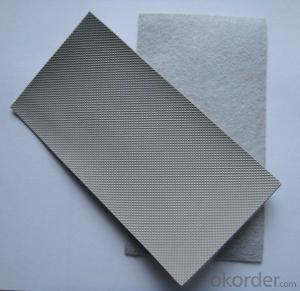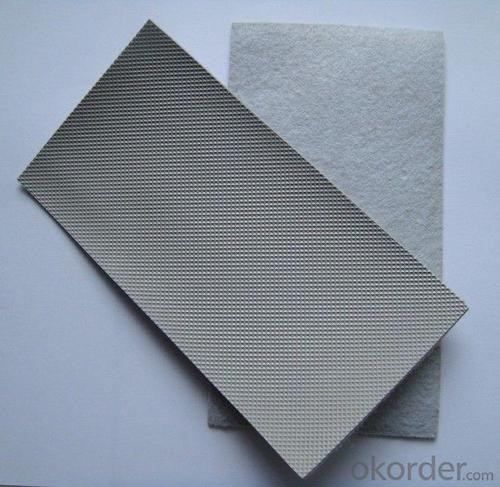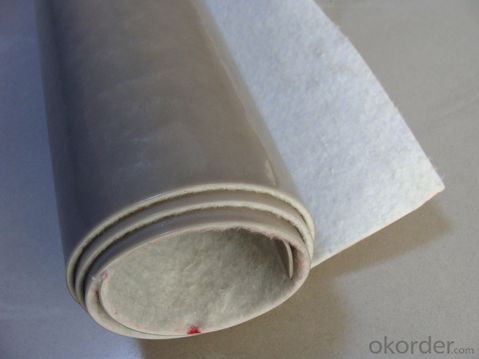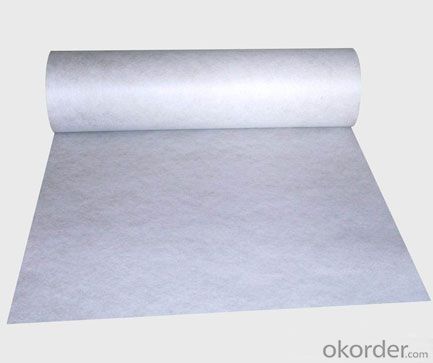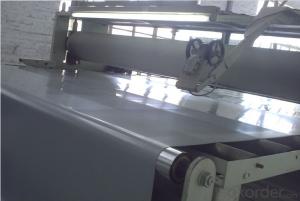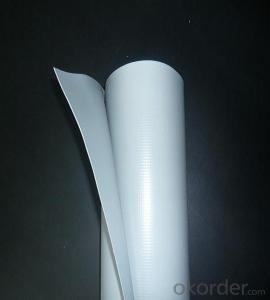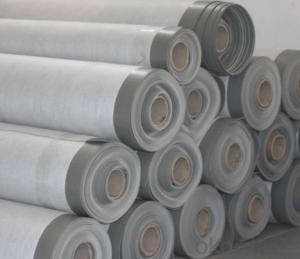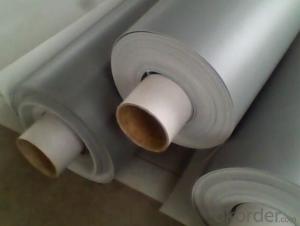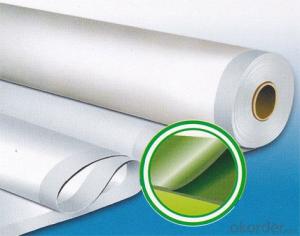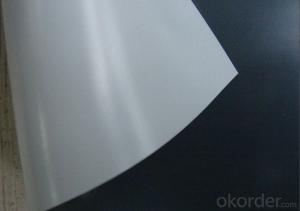PVC Resistant Waterproof Membrane with Fabric
- Loading Port:
- China main port
- Payment Terms:
- TT OR LC
- Min Order Qty:
- 1000 m²
- Supply Capability:
- 50000 m²/month
OKorder Service Pledge
OKorder Financial Service
You Might Also Like
Product Specification
name:High Quality PVC Waterproofing membrane
brand:Wanbao
width:2.05m
thickness: 1.2mm,,1.5mm,,2.0mm
Product Features
low -cost ,anti-aging ,anti -ultraviolet proformance ,shrinkage rate is high ,low temperature flexibility is good
Physical Property
1. Exposed to sunshine: UV rays resistance, long service life and aging resistance
2. Easy installation and dimensional stability: can be wieldable under wide range of temperature and experience minus dimensional change in thermal treatment
3. High tensile strength and elongation thus can accommodate movements of substrates
4.Good flexibility under low temperature, good adaptability to ambient temperature difference
5, Secure anti-puncture and good rooting resistance, no pollution caused to environment when being welded and good waterproofing choice for plant roofs
6. Good plasticity: convenient and fast treatment of detailed parts of corners and edges
Applicable scope
PVC sheet forms an effective barrier to liquid water or water vapor in the roof construction for industrial and civil engineering, underground engineering such as subway& tunnel, water conservancy such as water pools & ditch, shelter, grain depot, land filling, dyke, sewage treatment and basement.
Cautions
1. Do not put the membrane on a pollution, water and ice ground.
2. Construcion of waterproof layer operations can't be crossed, device shall be installed on the waterproof layer, parts should be done to strengthen the basis of device and to take protective measures.
3. Do not touch the waterproof layer with thorn sharp objects after it's has been completed, don't put sundries or any additional buildings above the waterproof layer to avoid damaging it.
FAQ of PVC Waterproofing Membrane
a.Can we get some samples before place order?
Answer: We can send the free samples to you by freight collect.
b.How many years can your PVC membrane guarantee?
Answer: We will guarantee the quality for 5 years at least.
c.Which countries you ever export the product?
Answer: We export the PVC membrane to South Africa, Middle east and even European countries.
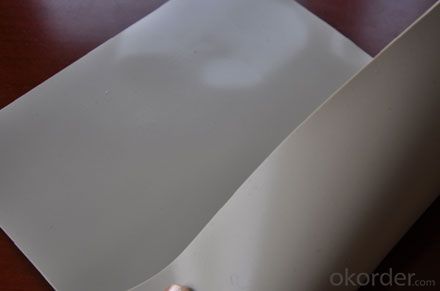
- Q: Can waterproofing membranes be used on foundation walls?
- Indeed, it is possible to utilize waterproofing membranes on foundation walls. These membranes possess a specific design that aims to impede the infiltration of water and are commonly employed on foundation walls to safeguard against moisture and water-related harm. Typically, these membranes consist of resilient materials like rubberized asphalt, thermoplastic, or PVC, which exhibit durability and resistance to water penetration. The installation of these membranes occurs on the outer side of the foundation walls, thereby serving as a highly efficient barrier against water, effectively averting its seepage into the basement or crawl space. Without a doubt, waterproofing membranes constitute an indispensable element in the realm of building construction, as they actively contribute to the preservation of the foundation's structural integrity, preventing adverse consequences such as water damage, mold growth, and foundation settlement.
- Q: Polyurethane and SBS membrane waterproof
- Paste asphalt linoleum. The cold binder material prepared by diluting the bitumen with solvent is developing. Various solvent and water emulsion asphalt or asphalt rubber coatings for roof waterproofing, should be strictly selected anti-cracking, tensile, anti-aging performance and good weatherability thick coating varieties. In addition, all kinds of ointment for dealing with the general building of the joints waterproof.
- Q: Can a waterproofing membrane be used for a bridge deck?
- Yes, a waterproofing membrane can be used for a bridge deck. In fact, it is a common practice to apply a waterproofing membrane to bridge decks to protect the structure from moisture ingress, which can lead to corrosion and deterioration. A waterproofing membrane acts as a barrier to prevent water from seeping into the concrete deck, ensuring the longevity and durability of the bridge. Furthermore, it can also help to reduce the potential for freeze-thaw damage, which is especially important in areas with harsh weather conditions. Overall, using a waterproofing membrane for a bridge deck is a reliable solution to enhance its lifespan and maintain its structural integrity.
- Q: Can a waterproofing membrane be used on plywood surfaces?
- Plywood surfaces can benefit from the use of a waterproofing membrane. Plywood is commonly used in construction, including outdoor projects like decks and balconies. However, plywood is not naturally waterproof and can suffer from moisture damage over time. To safeguard plywood surfaces from water damage, a waterproofing membrane can be employed. This membrane functions as a barrier, preventing water from penetrating the plywood and causing rot or decay. There exist various types of waterproofing membranes, such as liquid-applied membranes, sheet membranes, and peel-and-stick membranes. These membranes adhere to the plywood surface and create a tight seal. It is crucial to adhere to the manufacturer's instructions for proper application and ensure the plywood surface is clean and dry before applying the membrane. By utilizing a waterproofing membrane, plywood surfaces can be effectively shielded from water damage, prolonging their lifespan and preserving their structural integrity.
- Q: Can a waterproofing membrane be used in commercial construction?
- Yes, a waterproofing membrane can definitely be used in commercial construction. In fact, it is often a critical component of commercial building projects to protect structures from water intrusion and potential damage. Waterproofing membranes are designed to create a barrier against moisture and can be applied to various areas such as roofs, basements, foundations, and walls, ensuring a watertight and durable building envelope.
- Q: Does a waterproofing membrane require any special considerations for installation in high-humidity areas?
- Yes, a waterproofing membrane does require special considerations for installation in high-humidity areas. High humidity can increase the moisture levels in the air, which can affect the performance and effectiveness of the membrane if not properly addressed during installation. Here are some important considerations: 1. Moisture control: In high-humidity areas, it is crucial to control the moisture levels before installing the waterproofing membrane. The surface should be thoroughly dried, and any existing moisture issues or leaks should be addressed and fixed before installation. 2. Vapor barriers: Installing a vapor barrier beneath the waterproofing membrane can help prevent moisture from penetrating through the membrane. This is especially important in high-humidity areas where the moisture levels in the air are consistently high. 3. Proper ventilation: Adequate ventilation is key in high-humidity areas to reduce moisture buildup. Make sure there is proper airflow and ventilation systems in place to promote drying and prevent condensation, which can compromise the integrity of the waterproofing membrane. 4. Waterproofing membrane selection: Not all waterproofing membranes are suitable for high-humidity areas. It is important to choose a membrane that is specifically designed and recommended for such environments. Look for membranes with high moisture resistance and durability. 5. Professional installation: Proper installation is essential for the long-term performance of the waterproofing membrane. In high-humidity areas, it is recommended to hire professional contractors who have experience working in similar conditions and can ensure proper installation techniques are followed. By considering these factors, you can ensure that the waterproofing membrane performs effectively and provides reliable protection against moisture in high-humidity areas.
- Q: Can a waterproofing membrane be used for an underground structure?
- An underground structure can indeed benefit from the use of a waterproofing membrane. Essentially, this membrane acts as a protective barrier, safeguarding the structure against water infiltration. It is commonly employed on various areas, including roofs, basements, and other regions prone to water seepage. When utilized in an underground structure, like a basement or foundation, the waterproofing membrane serves as a shield, obstructing any water present in the surrounding soil or groundwater. Its primary function is to prevent water seepage, which has the potential to inflict harm on the structure and give rise to issues such as mold growth or structural deterioration. To achieve a watertight seal, the waterproofing membrane is typically applied to the exterior walls and foundation of the underground structure. Choosing a high-quality membrane that is specifically designed for underground use and adheres to industry standards is of utmost importance. Furthermore, proper installation techniques, such as surface preparation and sealing of seams, are critical in ensuring the effectiveness of the waterproofing membrane in an underground structure.
- Q: Can a waterproofing membrane be used for a deck?
- Certainly! A deck can indeed benefit from the utilization of a waterproofing membrane. These membranes are frequently employed to shield surfaces from water-related harm by forming a barrier that hinders water infiltration. In the case of a deck, the application of a waterproofing membrane can effectively impede water seepage into the underlying structure, thereby averting issues like decay, distortion, and other types of damage. It is imperative to select a waterproofing membrane specifically crafted for outdoor usage, capable of enduring various elements such as UV rays, temperature fluctuations, and considerable foot traffic. Furthermore, the proper installation and maintenance of the waterproofing membrane on the deck play a pivotal role in ensuring its efficacy and prolonged lifespan.
- Q: Is a waterproofing membrane resistant to mold and mildew growth?
- Yes, a waterproofing membrane is typically resistant to mold and mildew growth. The membrane acts as a barrier against moisture, preventing it from seeping into the building materials and creating an environment for mold and mildew to thrive.
- Q: Can a waterproofing membrane be used in cold climates?
- Yes, a waterproofing membrane can be used in cold climates. In fact, it is highly recommended to use a waterproofing membrane in cold climates to protect structures from moisture damage caused by snow, ice, and freezing temperatures. Waterproofing membranes are designed to be flexible and durable, allowing them to withstand extreme temperature fluctuations without cracking or deteriorating. They create a barrier that prevents water from seeping into the structure, which is crucial in cold climates where water can freeze and expand, causing significant damage to buildings and infrastructure. Additionally, some waterproofing membranes are specifically formulated to perform well in cold weather conditions, offering enhanced resistance to freeze-thaw cycles and ensuring long-term protection against water infiltration. Therefore, it is essential to use a quality waterproofing membrane in cold climates to maintain the integrity and longevity of structures.
Send your message to us
PVC Resistant Waterproof Membrane with Fabric
- Loading Port:
- China main port
- Payment Terms:
- TT OR LC
- Min Order Qty:
- 1000 m²
- Supply Capability:
- 50000 m²/month
OKorder Service Pledge
OKorder Financial Service
Similar products
Hot products
Hot Searches
Related keywords
